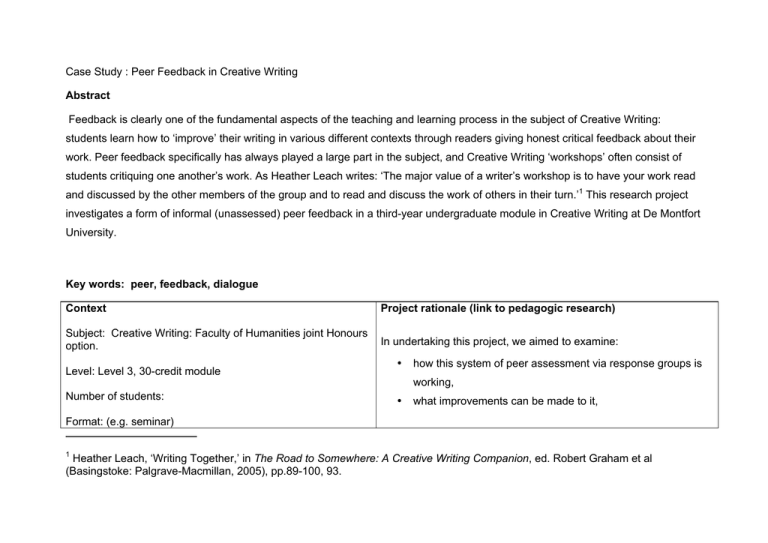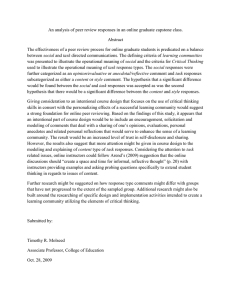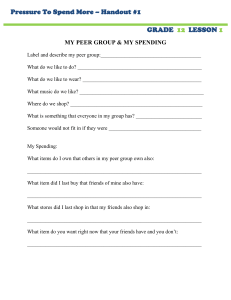students learn how to ‘improve’ their writing in various different... Abstract
advertisement

Case Study : Peer Feedback in Creative Writing Abstract Feedback is clearly one of the fundamental aspects of the teaching and learning process in the subject of Creative Writing: students learn how to ‘improve’ their writing in various different contexts through readers giving honest critical feedback about their work. Peer feedback specifically has always played a large part in the subject, and Creative Writing ‘workshops’ often consist of students critiquing one another’s work. As Heather Leach writes: ‘The major value of a writer’s workshop is to have your work read and discussed by the other members of the group and to read and discuss the work of others in their turn.’1 This research project investigates a form of informal (unassessed) peer feedback in a third-year undergraduate module in Creative Writing at De Montfort University. Key words: peer, feedback, dialogue Context Project rationale (link to pedagogic research) Subject: Creative Writing: Faculty of Humanities joint Honours option. In undertaking this project, we aimed to examine: Level: Level 3, 30-credit module Number of students: • how this system of peer assessment via response groups is working, • what improvements can be made to it, Format: (e.g. seminar) 1 Heather Leach, ‘Writing Together,’ in The Road to Somewhere: A Creative Writing Companion, ed. Robert Graham et al (Basingstoke: Palgrave-Macmillan, 2005), pp.89-100, 93. Dissertation-equivalent module, producing a ‘Portfolio’: a major piece of assessed creative writing (7500 words) plus 2500 word reflective commentary, journal and blog entries. Individual supervision and student-led response group meetings. • how it relates to the formative assessments provided by staff, • how it relates to other forms of peer feedback in third-year modules on other practice-based subjects in the Faculty, • what the system can tell us about the place of peer assessment within Creative Writing as a discipline, • whether there are benefits (or drawbacks) to the system which might be applied to other practice-based subjects beyond Creative Writing, and (indeed) to other, theoreticallybased disciplines. We also hoped that, by encouraging students themselves to reflect on the system of response groups, they would become more conscious of its place within their learning process. As Brockbank and McGill note, ‘making reflective practice accessible to student learners enables the latter to become more conscious of their own approaches to their learning and thereby promote critically reflective learning.’2 Anne Brockbank and Ian McGill, Facilitating Reflective Learning in Higher Education (Buckingham: S.H.R.E. and Open University Press, 1998), p.73. 2 Initiative outline Implementation advice (including resources) The project took the following steps: Recommendations arising from the survey for changes to the • Research Assistant and staff undertook a survey of students response group system include the following: on the Portfolio module, asking them to reflect on their experiences of the response group system, its advantages • • and disadvantages, and what could be improved. probably be advised to find and fix regular slots when The Research Assistant and staff also contacted and talked everyone in the group is free, and to keep to these slots if with representatives from other practice-based subjects in possible. the Faculty of Humanities, to ascertain what other peer • feedback mechanisms exist on their third-year modules. • at the beginning of the year, response groups should The Research Assistant and staff collated survey results, and drew up a report, with a series of conclusions, concerning the group meetings to ensure time is not wasted. • distributing a short handout on peer feedback at the start of assessment in the module, as well as in Creative Writing and the third year, and asking students themselves to list what practice-based disciplines more broadly. This paper they want from feedback and their response groups, and then represents a summary of the full report (which is available on collate responses into a short (one or two page) handout. request). This handout might be made available on Blackboard as well. RESPONSES TO THE SURVEY • if possible (given rising student numbers) it is a good idea to limit the number of students per response group to 5. 27 completed surveys, roughly 69%. This good response rate allowed us to extrapolate patterns and conclusions from the survey. staff should consider reinforcing guidance on how to give feedback at the start of the third year. This might include role of response groups, peer feedback and formative Out of 39 students registered for the Portfolio module, we received it is worth reminding students about booking rooms for their • it is worth writing a short statement (perhaps for the module handbook) outlining the criteria for allotting response groups. Benefits for teaching and learning Overall, the response group system of peer feedback seems to be working well, and students understand its importance. The response group system underlines the importance of receiving multiple perspectives on written work. Admittedly, students will always give more ‘weight’ to tutor feedback, because of assessment regimes; but students also understand the need for other readers in developing their work. Given the regularity of meetings reported in the surveys, many of the response groups also work as a way of ensuring that students are working on their projects throughout the academic year. In this and other senses, the response group system also functions as a kind of support mechanism for what might otherwise be a ‘solitary’ module.



